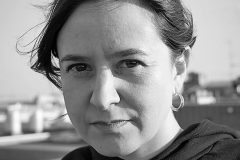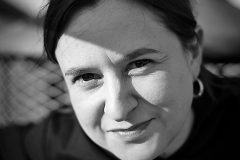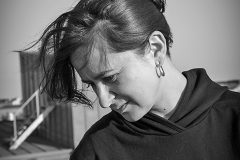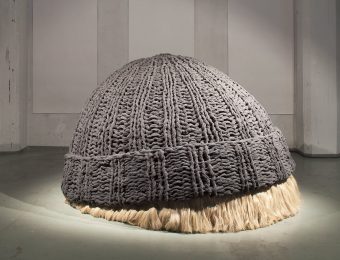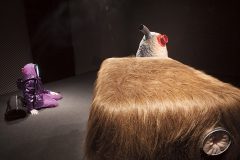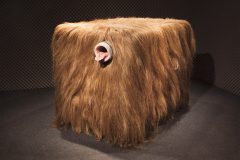I met Anna Estarriola many years ago in Corona bar in Helsinki. We have been friends since.
Anna Estarriola has been actively working as an artist for the last decade. She has surprised audiences with her own brand of special imaginary worlds within sculptures and installations.
Her art engages in discussions about politics, society and humanity. Quite often her works open up portals to new dimensions and fantasy worlds that work on a hypersensitive, emotional level where you can experience a special presence or sentience of inanimate objects. Her works are well known and appreciated in Finland, they have been shown in many Finnish galleries and museums, the latest one being this summer at Sinne Gallery in Helsinki. She has participated in many international exhibitions and will have her works shown for the first time in Estonia at Kunstihoone’s Galleries (Tallinn Art Hall Gallery and City Gallery) this autumn.
Today is a hot spring day; we climb up to the roof of her studio in Helsinki and talk about art and life.
Antti Tapio Kiuru (ATK): How did you become an artist?
Anna Estarriola (AE): I wanted to be an artist from an early age, I was attracted to and fascinated by art and its effects. And suddenly there was a way to communicate that felt somehow more suitable than others. That was about when I was 13 years old, it was very clear, and it has not changed; I’m really into it.
ATK: How did you end up in Finland?
AE: I was finishing my studies at the Sculpture Department at Barcelona University and it was my last semester there. I had the chance to go on an Erasmus exchange and I didn’t know exactly where. I ended up in Finland, and when I arrived something really clicked. I found a very inspiring environment and a place to concentrate. And, to be honest, that hasn’t changed either. I feel really grateful for this opportunity, and also for the shared respect I sense towards my profession.
ATK: Describe your methods. How do you work?
AE: I usually start working through intuition. I ponder about subjects and concepts, and then plan which shapes they will take and figure out how it will happen. I’m really fascinated by our human condition, by how we perceive reality and behave within it. Maybe what activates the shapes of my works are the thoughts and reflections on these topics. I think I work because I want to share wonders with others.
ATK: What is your favourite art form that you use?
AE: I have a background in sculpture, which I studied in Barcelona, and I also studied contemporary dance there. When I moved to Finland I focused on media arts and somehow that bound everything together. So, I think these forms are the most important in my practice so far. Maybe the combination of all of them through media arts is what spontaneously comes to mind if I have to pick one. Behind everything there is the need to share stories about things, and maybe the art form follows that.
ATK: What do you want to express through your art?
AE: It depends; different things. I’m interested in the acknowledgement of what is real, in the way we sense, in how we act and react, and in our communication structures. I want to reflect on what we categorize as certain, and on the multiplicity of ways we end up understanding the experience of being, and on the double-sided evolution of humankind, both the greatness and the fiascos. I also want to reflect on what changes and what remains, what appears through appearance, through image, and what disappears in voids. I want to speculate about the unknown, about how things work and about what things are made out of. I want to stage illusions and activate events, experimenting with the semantic possibilities of the media I use.
ATK: Do you have any special skills that you use in your art? What makes you different from other artists?
AE: (laughs) I don’t know, but what happens often to me is that I wish I had many skills that I don’t possess. So, I often end up trying to learn new things and feeling ignorant. I often have to reach out to experts in areas that I don’t have much of a clue about and, over time through lots of trial and error, some skills have slowly developed. Projects are different; they require different “this and that and how,” so it’s kind of a circle, and it is often frustrating, but at the same time this situation gives me a lot of drive and motivation, and it gets me to different environments and to meet different people to learn from and to collaborate with. I’m really grateful for that! But yes, it’s difficult to not know what you wish to know.
ATK: How do you find the spirit of your sculptures? They look like they have own personalities.
AE: The illusion of presence is what I’m after when I work with sculptures. I have a background in dance and performative arts, and I think that fuels much of this search and the intention of presence, because I’m really interested in what happens on the stage at the moment when the audience and performers meet. Actually, I am interested in all kinds of meetings.
When I work on the stage there is a sense of an orchestrated experience of presence. I think about what constitutes that really weird moment of being together – physically, but to a certain degree artificially – and these thoughts influence some of my works off the stage. And then I try to confer the illusion of presence in the inanimate, in the non-living, through all kinds of forms and means.
ATK: Can you separate your art life from your personal life?
AE: … I work with art. “I” is at the beginning of this sentence. I’m involved in my work, inevitably embedded in it, and my work means a lot to me. But I’m not interested in my life as a subject. I think my life is no more interesting than others’. I can’t avoid working through experience, as a living entity that perceives things and feels things, but I think I can separate art and my life – at least I think so.
ATK: How do you maintain your creativity?
AE: I don’t force anything; it just happens.(laughs) There is so much about this world and living in this world, living and leaving this life, so full of so many things to be attracted to or repelled by. And there’s truth in every step in between, the truth in all kinds of events.
ATK: So, you try to find truth?
AE: No, no! I actually think there is no truth. I mean, I’m really interested in the multiplicity of truths, as in the multiplicity of dogmas and paradigms. And I am interested in our relationship to science and systems of belief. I find them interesting as tools or platforms to explain mysterious or unknown things. I think about how we all try to carry on here, in different ways, and we try to understand things, relate to them, and there are so many forms and formulas, and there are so many of us.
There are so many connections and missed connections between us all. Maybe we are all so full of truth, being sometimes so right and sometimes so wrong, and being lost somewhere in between. I love the pulse of feeling “now it’s all so clear, but oh now I’ve lost it again.” I’m more interested in similarities than in differences. I’m keen on us all being equal beings who are hanging around trying to do something.
ATK: Back to this planet and your upcoming Estonian exhibition this autumn. What kind of work will you have in Tallinn?
AE: There will be two installations in Kunstihoone’s galleries, one in Art Hall Gallery and another in City Gallery. “Emerging Thoughts” is formed by an oversized knitted beanie that contains many heads. From within one can hear whispering voices, reeling off words and fragmented phrases. The work gives a hypothetical visual and audible form to the process of forming thoughts. “The Meeting” stages a scene that includes three prototype characters that attempt to communicate, one living inside the body of another, a Euro pallet-sized animal, and a meta-vital organ talk through abstract forms of language, pretending to be aware of themselves and the others.
ATK: What is your dream?
AE: There are so many, maybe all incomplete dreams keep you going.
Hive Mind
31.08 – 14.10.2018
Art Hall Gallery (Vabaduse väljak 6) and City Gallery (Harju 13)
Featuring: Anna Estarriola, Pia Siren, Yassine Khaled and Riikka Hyvönen
Curator: Stacey Koosel

